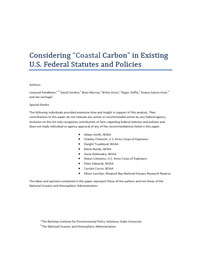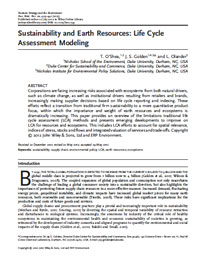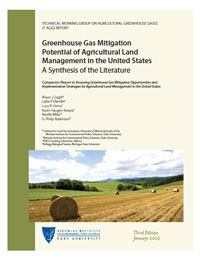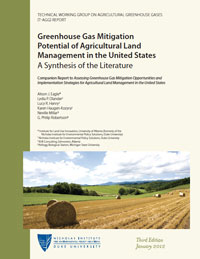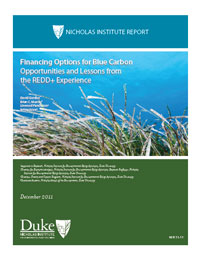Publications
Considering "Coastal Carbon" in Existing U.S. Federal Statutes and Policies
Many federal statutes and policies specifically require that impacts on ecosystem services be considered in policy implementation. Some federal policies directly include the economic value of certain ecosystem services in estimates of economic impact. Yet, we are unaware of a single federal statute, regulation, or policy that accounts directly for the carbon held in coastal habitats. Explicitly accounting for coastal carbon could change the outcome of federal policy actions for variety of federal statutes and policies, including the National Environmental Policy Act, Clean Water Act, and others. These statutes and policies allow for agency discretion in deciding which ecosystem services to include when considering alternative policies, plans, actions, and even assessments of the economic costs of damages to coastal ecosystems. Coastal carbon is an ecosystem service that could be included.
Sustainability and Earth Resources: Life Cycle Assessment Modeling
Corporations are facing increasing risks associated with ecosystems from both natural drivers, such as climate change, as well as institutional drivers resulting from retailers and brands, increasingly making supplier decisions based on life cycle reporting and indexing. These efforts reflect a transition from traditional firm sustainability to a more quantitative product focus, within which the importance and weight of earth resources and ecosystems is dramatically increasing. This paper provides an overview of the limitations traditional life cycle assessment (LCA) methods and presents emerging developments to improve on LCA for resources and ecosystems. This includes LCA efforts to account for spatial relevance, indices of stress, stocks and flows and integrated valuation of services and trade-offs.
Greenhouse Gas Mitigation Opportunities for Livestock Management in the United States
Although livestock management is a small contributor to overall greenhouse gas (GHG) emissions in the United States, it makes up half of all U.S. agricultural emissions. Changes in livestock management can benefit air and water quality and help slow global climate change. This brief summarizes key points from the report "Near-Term Options for Reducing Greenhouse Gas Emissions from Livestock Systems in the United States: Beef, Dairy, and Swine Production Systems," which outlines strategies for managing GHG emissions from livestock systems and reviews options for quantifying and accounting for farm-scale implementation of such strategies.
Near-Term Options for Reducing Greenhouse Gas Emissions from Livestock Systems in the United States: Beef, Dairy, and Swine Production Systems
Although livestock management is a small contributor to overall greenhouse gas (GHG) emissions in the United States, it makes up half of all U.S. agricultural emissions. Changes in livestock management can benefit air and water quality and help slow global climate change. The objective of this report is to synthesize and communicate the fundamental information necessary for designing agricultural GHG mitigation and reporting programs. It will be of use to private or voluntary markets and registries, commodity group and supply chain initiatives, and regulatory agencies. It summarizes strategies for managing GHG emissions from livestock systems and reviews options for quantifying and accounting for farm-scale implementation of such strategies.
Greenhouse Gas Mitigation with Agricultural Land Management Activities in the United States—A Side-by-Side Comparison of Biophysical Potential
Responsible for 6% of U.S. greenhouse gas (GHG) production, agricultural land use has significant potential to reduce these emissions and capture additional carbon in the soil. Many different activities have been proposed for such mitigation, but assessments of the biophysical potential have been limited and have not provided direct comparison among the many options. We present an in-depth review of the scientific literature, with a side-by-side comparison of net biophysical GHG mitigation potential for 42 different agricultural land management activities in the United States, many of which are likely applicable in other regions. Twenty of these activities are likely to be beneficial for GHG mitigation and have sufficient research to support this conclusion. Limited research leads to uncertainty for 15 other activities that may have positive mitigation potential, and the remaining activities have small or negative GHG mitigation potential or life-cycle GHG concerns. While we have sufficient information to move forward in implementing a number of activities, there are some high-priority research needs that will help clarify problematic uncertainties.
Stacking Ecosystem Services Payments: Risks and Solutions
Healthy ecosystems provide many services to society, including water filtration, biodiversity habitat protection, and carbon sequestration. A number of incentive programs and markets have arisen to pay landowners for these services, raising questions about how landowners can receive multiple payments for the ecosystem services they provide from the same parcel, a practice known as stacking. Stacking can provide multiple revenue streams for landowners and encourage them to manage their lands for multiple ecosystem services. However, if not well-managed, it may also lead to a net loss of services.
The Potential Role for Management of U.S. Public Lands in Greenhouse Gas Mitigation and Climate Policy
Management of forests, rangelands, and wetlands on public lands, including the restoration of degraded lands, has the potential to increase carbon sequestration or reduce greenhouse gas (GHG) emissions beyond what is occurring today. In this paper we discuss several policy options for increasing GHG mitigation on public lands. These range from an extension of current policy by generating supplemental mitigation on public lands in an effort to meet national emissions reduction goals, to full participation in an offsets market by allowing GHG mitigation on public lands to be sold as offsets either by the overseeing agency or by private contractors. To help place these policy options in context, we briefly review the literature on GHG mitigation and public lands to examine the potential for enhanced mitigation on federal and state public lands in the United States. This potential will be tempered by consideration of the tradeoffs with other uses of public lands, the needs for climate change adaptation, and the effects on other ecosystem services.
Greenhouse Gas Mitigation Potential of Agricultural Land Management in the United States: A Synthesis of the Literature (Third Edition)
This document, now in its third edition, is a comparision report to the T-AGG report Assessing Greenhouse Gas Mitigation Opportunities and Implementation Strategies for Agricultural Land Management in the United States. The third edition updates the side-by-side comparision of the biophysical greenhouse gas mitigation potential of 42 agricultural land management activities with newly available and previously unincluded data from field experiments, modeling, and expert review. Activities with sufficient research estimates of mitigation potential are now all derived from original individual data points of side-by-side experiments (previous editions included expert and modeling estimates and applied different weighting factors).
Climate Change Mitigation and Agriculture
A new book features two chapters on reducing agricultural greenhouse gas emissions penned by researchers at the Nicholas Institute for Environmental Policy Solutions—Brian Murray and Lydia Olander. The 456-page book reviews the state of agricultural climate mitigation globally and focuses on the design and implementation of activities to reduce emissions and increase carbon storage.
Financing Options for Blue Carbon: Opportunities and Lessons from the REDD+ Experience
When development pressures transform mangroves, seagrass, and coastal wetlands, carbon stored in their biomass and soil is released to the atmosphere as carbon dioxide. One way to counter these pressures and thereby conserve the carbon stored in these habitats (referred to as “blue carbon”) is to provide payments for the environmental services they provide. This paper analyzes current and potential options for carbon mitigation payments as a source of blue carbon finance. With other work that has focused on the payments needed to secure blue carbon, this paper can help stakeholders assess funding gaps and direct scarce resources to those activities that will provide the greatest blue carbon benefits.

